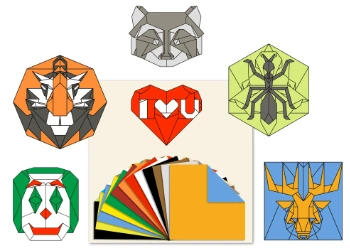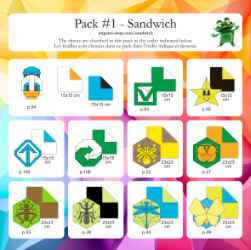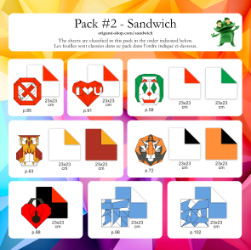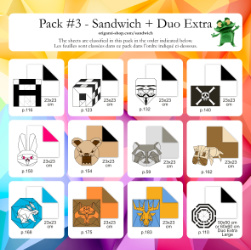Gutes Geschäft:
Um alle Modelle in diesem Buch zu falten, fügen Sie eine Packung mit 35 speziell ausgewählten Origami-Blättern hinzu.
43.33 € 34.66 € (-20%)
Packungsdetails unten. |  |
Mi Wu ist einer der führenden Vertreter der chinesischen Origami-Gemeinschaft. Er ist Mitautor des Buches "One Water One World" und Autor seines ersten Solo-Buches "Duo-Color Origami".
In diesem zweiten Buch treibt er das Konzept des Farbwechsels mit noch innovativeren Modellen voran, aber auch mit Modellen, die aus einer Mischung von zwei Quadraten gebildet werden, wodurch sich die Möglichkeiten des Farbwechsels vervielfachen. Seine eleganten und einfallsreichen Faltfolgen werden Ihnen viele Stunden mit spannenden Faltungen bescheren. Ihre 31 Modelle bieten eine originelle und einzigartige Herausforderung, mit der Sie neue Wege im Origami erkunden können. Mi Wu ist auch der Erfinder einer neuen Gestaltungstechnik, die er in einem Artikel über die Optimierung seines Würfelmodells noch weiter vertieft.
Einzelheiten:
-
- 192 Farbseiten
- Vollständige Schritt-für-Schritt-Faltanleitung für 31 Modelle
- Sprachen: Englisch und Französisch (alle Texte, einschließlich der Diagramme)
Verfügbare Formate (bitte oben auswählen):
- Taschenbuch mit digitaler Buchoption
- Digitales Buch allein
 | Digitale Ausgabe: Sind Sie zu ungeduldig, um auf die Lieferung des Buches zu warten? Oder möchten Sie eine Version für Ihr Smartphone oder Tablet? Schauen Sie sich die digitale Option oben an. Sie können es sofort unter "Ihr Konto>Meine Downloads" herunterladen, sobald wir Ihre Zahlung akzeptiert haben.
pdf-Datei mit Schutzabdruck. Sie können Ihre Datei noch nicht hochladen? Ihre Vorbereitung dauert manchmal nur wenige Minuten! Bitte aktualisieren Sie die Seite in Kürze. |
Details zum ausgewählten Papierpaket:
35 Blätter, die speziell aufgrund ihrer Größe, Farbe und Textur ausgewählt wurden, für perfekte Faltergebnisse.
Preis für dieses Paket: 43.33 € 34.66 € (-20%)



Reviews by great origami masters for his first book
I really like this book! Duo origami has a long history, but for many years it was not much more than penguins and pandas. It received a major boost from John Montroll’s landmark book, “Origami Inside-Out”, and since then origami artists have continued to show great creativity in exploring duo-colored subjects. But the designs here take the genre to an entirely new level; the works are clever, yet readily foldable, and display both beauty and inventiveness.
Robert J. Lang
Mi Wu shares some insight into his very deliberate and color-change specific design methods. His essay "Design Secrets" is a fascinating read. His concepts are written in a logical way that is sure to inspire many new and existing designers to use in their own bags of tricks.
Quentin Trollip
This is a fascinating book offering a new slant on two-colour origami design. The author explores many avenues to achieve dramatic colour changes in both flat and three-dimensional designs. He presents the background as well as his principles for this intriguing area of origami, which any enthusiastic folder should carefully study.
Dave Brill
When taking color-change into account, origami designing leaps to another level. It only took Mi Wu 5 years to dig deep into this subject. Each work is a painting done by folding paper. Since the first time I saw his works, I have been wondering “How could he achieve that level?, How can I learn that magic?” Now I have my answer by reading his book: “Duo-color origami”. In the book you will find the secret behind the miracle thanks to the creator’s generosity in providing thoughtful articles about his process.
Nguyen Hung Cuong
Seeing his models for the first time a few years ago left me dumbfounded. The designs have compelling folding sequences with little repetition among the entire collection of origami figures. The difficulty level for the book as a whole is fairly high and the author dedicated 12 pages to explain in a fair amount of detail how he goes about designing color-changed origami.
Shuki Kato
Color change is one of the best resources in the designer's arsenal to make any model more attractive. Mi Wu has elevated the concept to awesome new heights making the bi-colored patterns the very topic of this book. How the author comes up with such complex arrangements of shapes in origami is quite baffling. The alchemy of his methods unfolds before our eyes in a whole chapter devoted to unveiling and explaining the secrets of color-change design. Mi Wu's book is one of the most alluring of the last few years.
Román Diaz